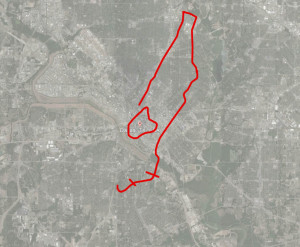
I’m using this again, because recently I’ve been counting up the highway lane miles per capita (actually, per 100,000) of just the core cities. All other data I’ve assembled, uses metropolitan areas because that’s how you find it in census data and TTI and various other aggregators, as you can find here and here.. It matters from this perspective, because the core cities often bear the infrastructural burden for larger areas, hence often the need for metropolitan governing bodies to help offset the cost burden of the core city. However, using the region to help fund the infrastructure at the core, doesn’t offset the negative impact that the large scale, long-trip infrastructure still has on the local networks necessary for 1) daily life and 2) real estate value. The disruption of networks creates edges that deflate land value.
The core is still bearing that burden while the highway infrastructure subsidizes the commute and in turn the real estate to live outside the city. Meanwhile, the city then has to deal with the congestion, the pollution, the traffic accidents, and the deflated land values at the core. This goes for trains too. Rail lines also disrupt local, short trip networks when they are at grade. This is why subway lines are buried, why heavy rail lines only enter cities like Paris and London to a certain point, and why Milan has moved one of their major rail stations a few blocks further away from the core to create more high density, local network derived real estate. The high density and the local network part are related, provided “reach” is still high. Reach is all the destinations that you can get to or can get to you, often meaning there is a high density context around.
Above is Paris. Highways are in red, rail lines in black. Notice the rail lines only get so far before they either go underground or reach a Gare.
All of this brings me to the actual data I’ve assembled by actually measuring the length of highways within city boundaries, counting the widths at every mile or so interval (the lane totals tend to be pretty predictable when the shift wider or narrower, usually at other highway/major road interchanges). Then I compared these to the latest population numbers for the specific cities.
Here is what I’ve accrued thus far, the city by city data tends to find their way into categories, as you’ll see:
City | Lane Miles per 100,000
London: 2.37
Vancouver: 3.13
Barcelona: 5.38
Paris: 8.15
Stockholm: 13. 72
Manhattan: 10.83
Portland: 38,84
Detroit: 59.31
Austin: 66.53
St. Louis: 67.54
Houston: 91.40
Dallas: 96.38
That seems pretty bad. Really bad. Until…
Kansas City: 147.74
This is interesting because KC and StL are far and away the worst from a metro standpoint. However, KC’s metro actually drops their city number and StL the greater burden is actually exterior to the city proper. Some of this has to do with StL’s boundaries being quite small.
But this is bad, why? The simple equation is cost burden over tax base, a burden which will become increasingly localized as taxpayers become less interested in bailing out people elsewhere. This is Thatcher’s America and you’re on your own. However, the scariest part is that the majority of these roads (on the extreme end of the list) are still on their first life span, funded primarily by federal government. What happens when the bill is due to replace them? While there is some federal money to be had, they won’t kick in the 90% which is pretty typical of new highways/interstates.
Making matters worse is that the CBO projects the federal highway account will have a shortfall of $92 billion by 2023.
So what about state money? TxDOT is already swimming in $14-18 billion in debt depending upon whose numbers you read. Add to that TxDOT says they need $1 billion in additional funds just for maintenance on top of their current $10 billion yearly budget. And (!), TxDOT says they need another $3 billion a year to fight the bogeyman of congestion. The result is more taxes with lower tax base.
And all of these people in charge see the only problem as CONGESTION and the only solution is MORE CAPACITY, which then feeds itself, further disconnecting people from destinations all but ensuring more driving, more costs on both individuals and public coffers, and MORE CONGESTION thus the need for MORE CAPACITY.
How do we stop the cycle of stupid?
Well, for starters we don’t listen to certain planners who are stuck in the 1980s despite whatever credentials they possess. Jane Jacobs wrote about credentialism in her final book. I suggest you give that a read. Also, we shouldn’t listen to tiresome fools like Joel Kotkin who want you to live in their particular vision of the world. Or Robert Bruegman. Yet these people keep finding themselves on panels.
Which brings me to my final point. I was at the Resilient City forum put on by Dallas Institute for the Humanities. The keynote speakers were very good as I was live tweeting the event. Particularly Eric Klinenberg. The local panelists with the keynotes were not terribly informative. Not at all actually.
One of the reasons is that the issue of resilience being dependent upon connections came up, yet only once did the issue of infrastructure get brought up and that was in the Q&A period by someone in the very back who asked, “have any cities ever tried to move traffic away from the core to make more room for people and parks?” I’m paraphrasing based on a hazy memory, but the key points are there, particularly the part about “any cities,” ie he was asking for specifics and lessons.
So naturally the panel turned to the nominal city planner on the panel (because they would know!), who then did not mention any cities(!!) but then said if we did that all of the vitality would move out to 635. Wha? That’s it. That was the entirety of the expertise provided. Little more than antiquated conventional wisdom. There was no mention different kinds of traffic, regional and local. There was no differentiating intracity roads from intercity roads.
There was no mention of the cities around the country that HAVE differentiated the bad traffic from good traffic, that have found various ways to improve their cars while nudging down demand for vehicular travel in the core. There are the congestion charges of London and Stockholm. There are the highway removals in San Francisco and Seoul and a variety of other places. None of which have ever regretted the move. None. Instead, we got a shovel full of the conventional wisdom that blamed (and apparently continues to blame) beltways on the death of Main Street, which is quite oversimplified.
This is why I, as a planner, and the general public has so little faith left in the profession of planning and city building. Their hopes are inflated by pretty pictures and 9 month public processes and books that cost hundreds of thousands of dollars and then, what? And then nothing. Or some bond package proposals that add some superficial decoration masquerading as urban design. Nothing about actually shifting real estate markets, opportunity areas for investment, how broke public agencies can leverage assets to do so, or how to increase general livability and opportunity for the citizenry.
Instead, nope. “We have to be worried about pushing traffic and vitality outwards. That cow is well out of the barn. The retail has followed the rooftops of pushing it out already. If we want a resilient city, we need a connected city, like was mentioned. Or a network city, like was mentioned at the simultaneous panel, which also unfortunately thought network only in the most superficial, digital sort of way. We can’t make connections unless we’re closer to each other. That means we need an infrastructure of resilience, that favors the short trip, that doesn’t mandate every person buy and maintain a car, that doesn’t bankrupt our treasuries simply to build MORE CAPACITY, that actually looks more like the cities at the top of the list. It’s time for some actual vision and leadership Dallas.






